Here’s something I want to share.
You’re probably here right now because you’ve realized that trading is more than just technical analysis…
…and it’s more than just making money and strategies, right?
Well, if what I’m saying resonates with you, there’s something else I need to tell you:
You’re more than halfway to profitability!
It’s true!
By now, you’re waking up to the fact profitability comes from mastering oneself.
However, a million-dollar question remains:
How can I develop consistency in trading?
Well, rest assured, my friend.
In today’s guide, I’ll share with you a complete blueprint to achieve just that – consistency in trading.
Specifically, you’ll learn:
- What consistency in trading means, and what it looks like practically
- The biggest factor all traders need, to achieve consistency in trading (it’s not what you think)
- My personal trading routine (which platforms I use and how I use them daily)
I’ll make sure that after you finish reading this guide…
…You will have much better clarity and a step-by-step plan to achieve consistency in trading.
Are you ready?
Then let’s get started…
What does consistency in trading look like? (and why do some traders remain inconsistent)
A simple truth is that trading results always depend on how consistently you execute your strategy.
Because the bottom line is…
…if you want consistent results, then you need a consistent set of actions!
Do you keep changing your strategy or tweak your indicators every 2-3 losing trades?
Then, don’t be surprised if your results become inconsistent.
But what does consistency in trading look like?
Well, it all boils down to these three things…
- Knowing and choosing your trading style
- Knowing and choosing your trading methodology
- Scaling your capital appropriately
I know. The third one looks out of place.
But let me explain…
Knowing and choosing your trading style
It’d be best to take notes here…
..because ‘trading style’ is a useful concept I’ll throw around in this guide quite a lot.
It can help answer common questions like:
“What is the best timeframe to use in trading?”
“What is the best strategy?”
…and more!
To break it down, the first step is choosing your trading style from the following:
- Day trading (below 1-hour timeframe)
- Swing trading (4-hour timeframe to daily timeframe)
- Position trading (daily timeframe to weekly timeframe)
In reality, you’re simply choosing which timeframe to lock onto – because jumping between timeframes isn’t going to work!
Now, it could be that your first choice is to be a day trader.
You want that quick profits in the markets, right?
But be aware you’ll also experience quick losses.
Of course, I won’t stop you from being a day trader.
To be honest, I suggest you try it out at least once!
Two things you should always keep in mind when choosing a trading style, though, are the following:
- If it fits your trading lifestyle
- If it’s compatible with your mental capacity
It doesn’t make sense to want to be a day trader if you’re juggling responsibilities in life, right?
In fact, to help you learn more about the trading styles I’m sharing with you and how to work them, feel free to check out any of these guides below:
Intraday Trading: 4 Things You Must Know If You Want To Succeed
The NO BS Guide to Swing Trading
The NO BS Guide to Position Trading
So, once you have picked the right timeframe, next is choosing your trading methodology…
Knowing and choosing your trading methodology
Understanding your trading style focuses on knowing which timeframe you will look at consistently.
But trading methodology?
Well, it’s all about knowing how you should enter and exit your trades!
So, what are the different trading methodologies out there?
Let me share them with you…
Trend-Following
The main objective here is to capture the whole trend until it bends.
If the trend doesn’t work out?
Simply exit the position quickly and move on to the next trade!
But if it goes your way?
Then, you can expect monster risk to reward setups as the trend develops!…
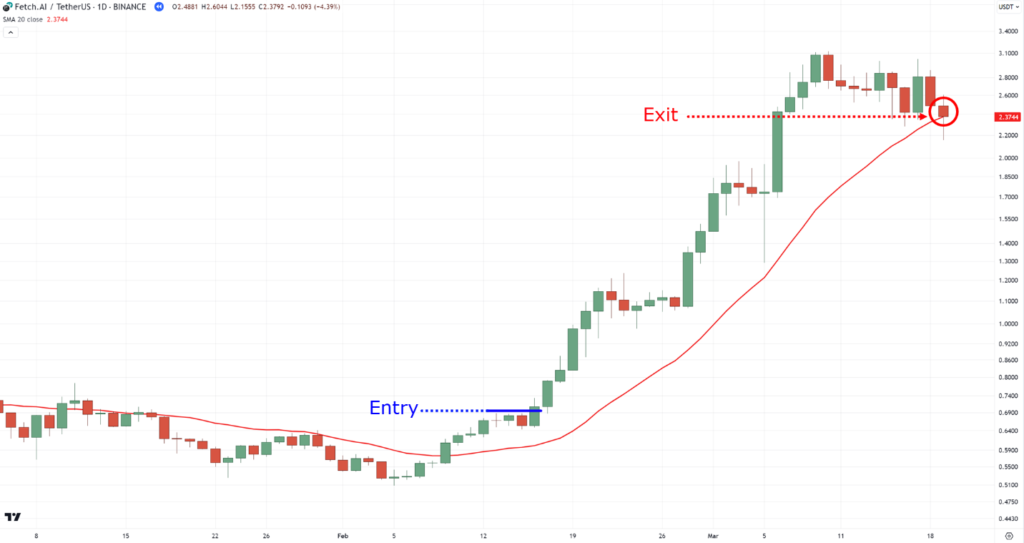
But of course, it also means you have to endure pullbacks – which may not be easy, mentally.
Adopting a trend-following approach typically means that your win rate will probably be around 40% to 50% (which is normal, of course!)
Momentum Trading
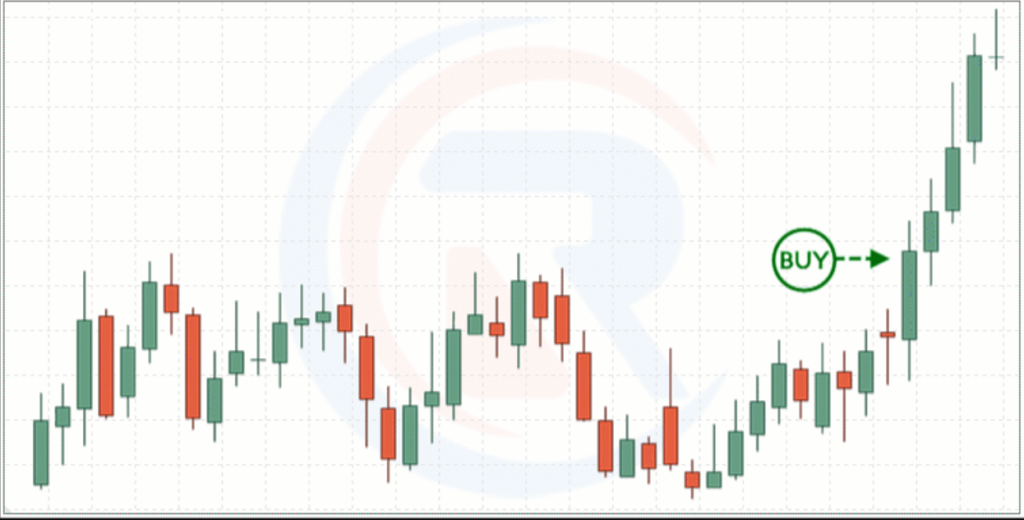
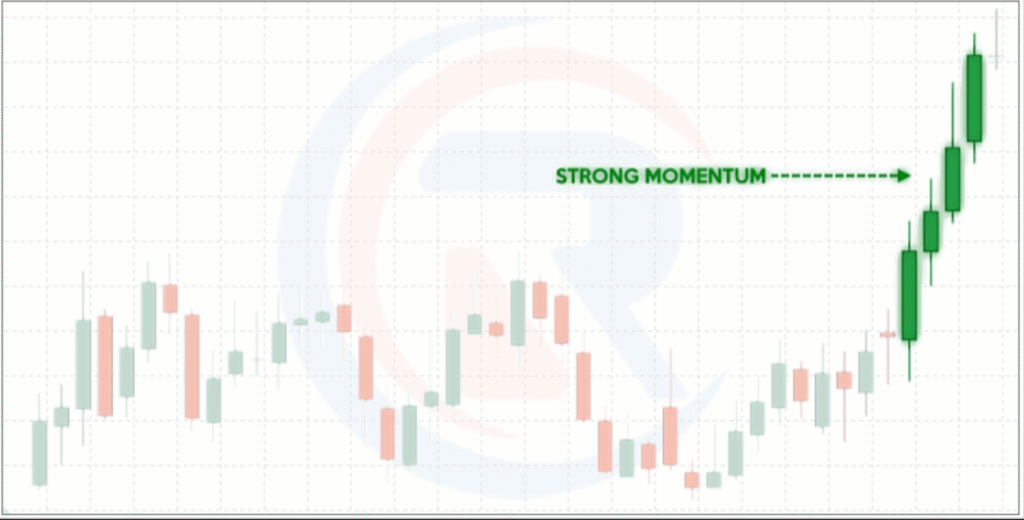
In contrast to trend-following…
Momentum trading means that you’re only looking to capture the short-term strength of the markets.
This means that your trades wouldn’t last long compared to trend-following, and you don’t need to endure market pullbacks.
…as once the market loses its momentum?
You exit immediately!
Of course, one downside is the frequency of trades.
Another is your trading portfolio would require more “maintenance”, as you’d be entering trades – possibly daily!
However, due to the short-term nature of momentum trading, your win rate will be higher, perhaps around 50% to 70% win rate.
Mean Reversion
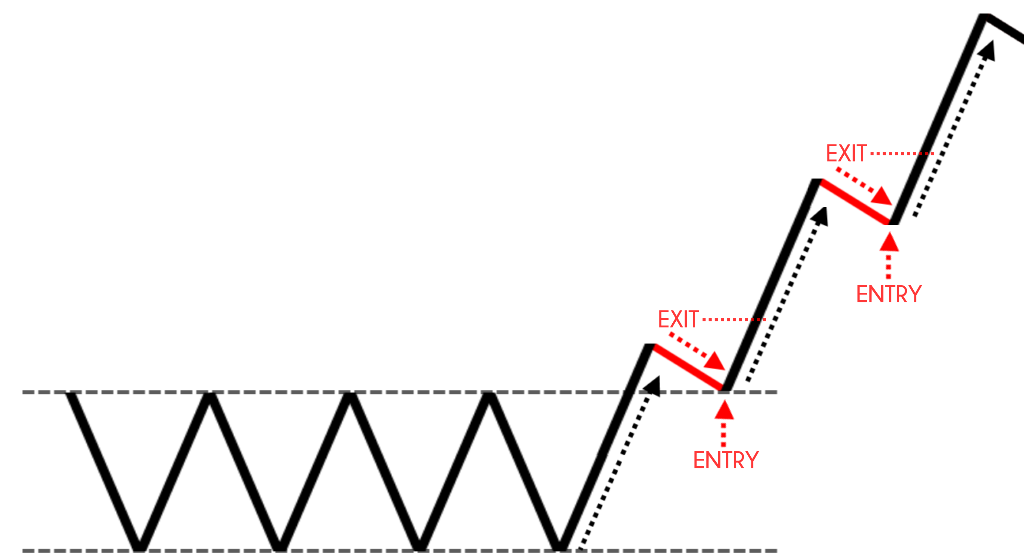
This is simply just another term for “pullback trading”, where you try to take advantage of the weakness of the market!
This is a trading methodology that may not be for everyone – as you are entering a trade against the current market momentum (the opposite of momentum trading!).
But if done right, you want the market to “come to you” at a cheaper price to take advantage of!…
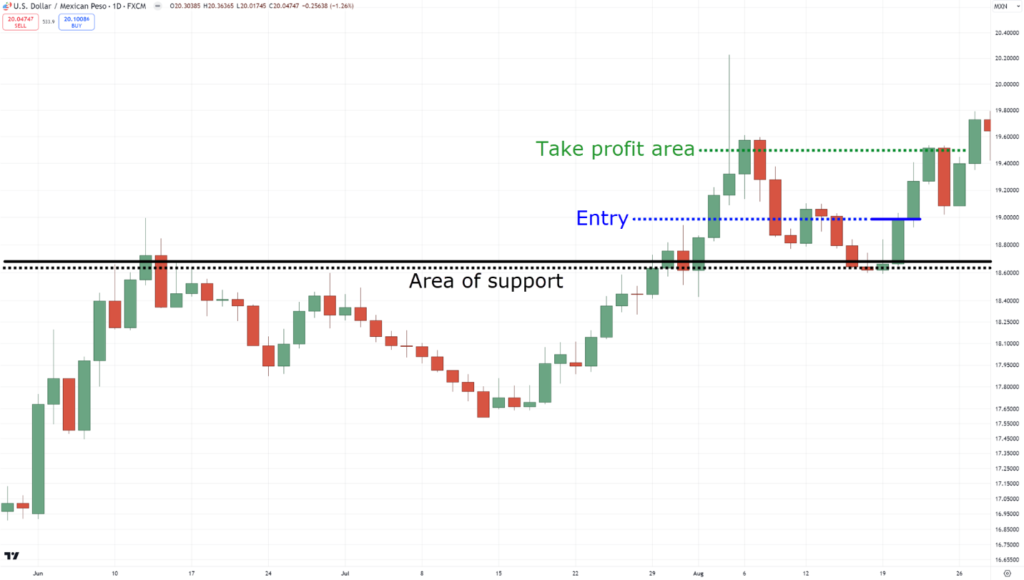
Like momentum trading, your trades can be short-lived and potentially have a similar win rate of 50% to 70%.
So, as you can see…
No trading methodology is perfect.
They all have their Pros and Cons.
But what matters is you find a trading methodology where the Pros outweigh the Cons – for you!
Of course…
There are probably more trading methodologies, so don’t let your education stop here.
However, these are the trading methodologies I’ve been using for years.
Nonetheless, knowing the difference between trading style and methodology is the key aspect to building your identity as a trader.
Scaling your capital appropriately
I think these rules are worth memorizing:
Don’t invest the majority of your savings when starting to trade.
Don’t put all your retirement funds in when starting to trade.
Don’t borrow a huge amount of money when starting to trade.
If you don’t follow these rules, it won’t matter if you have the “best strategy” in the world…
…the moment you start live trading, you’re trading with a confidence you don’t have!
And once you start doing that, it’s a clear recipe for disaster!
Now, I’m not telling you to avoid trading altogether.
Rather, I’m advising the opposite – the best way to gain experience in trading is through live trading.
To begin, once you’ve successfully worked out your trading style and methodology…
Start small.
If you have $10,000 then I suggest you start with a fraction of that budget, such as $1,000
If you have $1,000 then start smaller, around $500!
Starting as soon as you can and as small as you can is one of the keys to long-term consistency in trading.
Why?
Because when you have less attachment to your trading account, you can focus more on the process than the result.
After you start developing consistency in trading and getting better results…
…that’s the time you should consider adding more funds!
In short, start small to build up your confidence and add more funds as you progress in trading.
I think that makes sense, right?
Now, I must admit that successfully mastering those three aspects can take months or even years.
You have to go through a lot of trial and error and a process of unlearning before finally reaching the right trading plan for you.
It’s only by learning what didn’t work for you in the past that you can have confidence in the trading method you will eventually choose.
Always try to remember that!
But you’re likely asking…
“Isn’t there a way to accelerate this process?”
Luckily – you bet there is!
And I’ll do my best to share them in the next section…
A three-step process on how to achieve consistency in trading
At this point…
I’ve shared with you a practical process for achieving consistency in trading.
However, one thing I have left out is the “you” part.
What should you do when you’ve just lost half of your account?
What should you do when you’re holding into losing trades, and desperate for a better strategy?
What should you do when managing other people’s money and things are going south?
You may have so many challenges right now.
Even when you have a blueprint or a strategy that works, it’ll almost be impossible to follow them through.
The reasons?
Attachment and expectations.
That is why, in those situations, the first process towards achieving consistency in trading is to…
Step 1: Stop Trading
I get it.
You want to be a full-time day trader.
You want trading to be your primary source of income.
You’ve seen others get a +1,000% gain in a matter of a few months (because everyone only boasts about their wins), and you want to achieve the same thing.
But the truth is that if that’s your main focus in trading then you will start to waver and make psychological mistakes in trading the moment you experience losses.
And if you’re already in that spiral of losses, the worst thing you can do is to add more funds!
Why?
Because now you’re “expecting” to get those losses back!
So, instead…
If you want to achieve consistency in trading, you must put yourself in a state of learning.
It’s a kind of state where you’re not expecting anything from the markets, and you’ve submitted yourself to learning from your mistakes and trying something new in trading (to discover what works and what doesn’t).
And at this stage, the only way to begin doing that is for you to stop trading.
By hitting that big pause button, you can clear your mind and let go of your expectations, removing the attachment that you have from the markets.
Of course, it is easier said than done, and I understand that stopping trading can take some time.
But a crucial step, nonetheless.
Step 2: Try out different trading methodologies
Once you’ve put yourself in a state of learning as a trader, you’ve passed through a major hurdle in developing consistency in trading.
Because now is the time to explore other trading methodologies out there!
Whether it’s fundamental trading, technical trading, algo trading, there are all kinds to choose from…
So try each one out and learn as much as you can!
Because once you’re in that stage of learning or being open to new information…
You will see new pieces of knowledge as opportunities to grow.
Give up seeking the ‘holy grail’ strategy that never loses.
Step 3: Develop a proper trading routine then start small
This is the cream on top of developing consistency in trading.
There is no way around it – you must establish a trading routine.
This means knowing what specific day of the week or time of day you should:
- Develop your watchlist
- Check your charts and find trading setups
- Execute trading setups
That’s right – you must know when you should and should not check your charts.
This step is all about trying to make your trading business as efficient as possible!
Again…
All of these steps will take some time, and depending on your situation, there may be extra lessons to learn on the way.
But provided you maintain direction, you’re closer than you think to becoming consistent as a trader!
Now, practical advice is the most useful and so I’m going to reveal my exact trading routine, including the kind of strategy and platforms that I use…
…because I want to show you the result of going through all of the steps and blueprints in this guide!
Sounds good?
Then read on!
An example of how I maintain consistency in trading
Before I start, here are a couple of things that I would like to share with you:
First, growth never stops in trading.
This means that there will always be times when I have to adapt and change my trading processes, so I highly suggest you do so as well!
Second, in building more confidence in trading…
I may even have started one or two new trading portfolios by the time you read this guide.
And lastly…
Everything I will share with you is the result of years of trial and error to achieve consistency in trading.
I have tried plenty of methods in the past that did not work, believe me!
Make sense?
Great, then let’s get started!
Overview of portfolios and trading methodology
Currently, I trade using two portfolios.
First is a systematic trading portfolio.
What is systematic trading, you may ask?
Well, it’s where everything is black and white with no discretion.
If the price closes makes a new 200-day high…
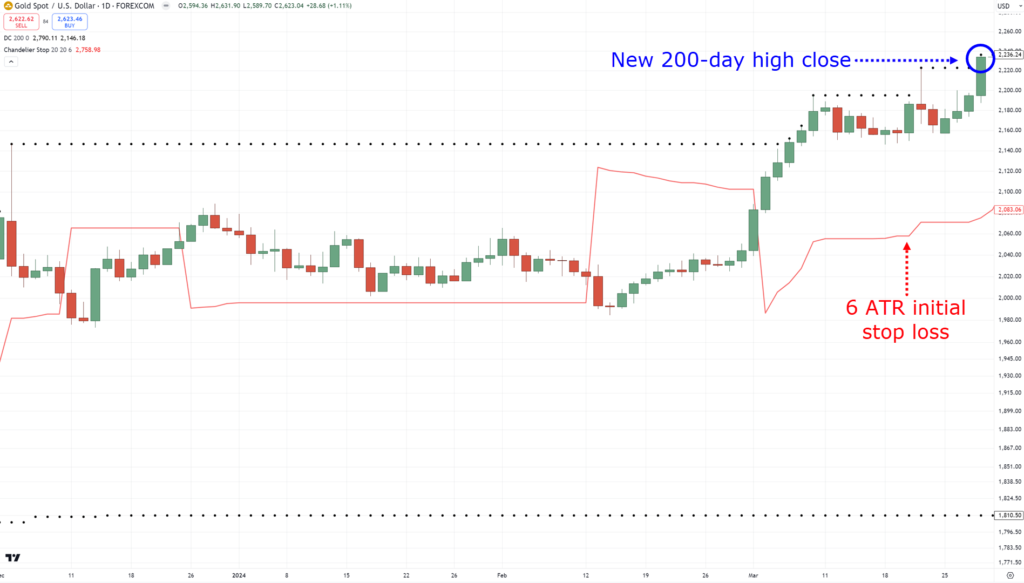
Then enter long with a 6 ATR initial stop loss and trailing stop loss…
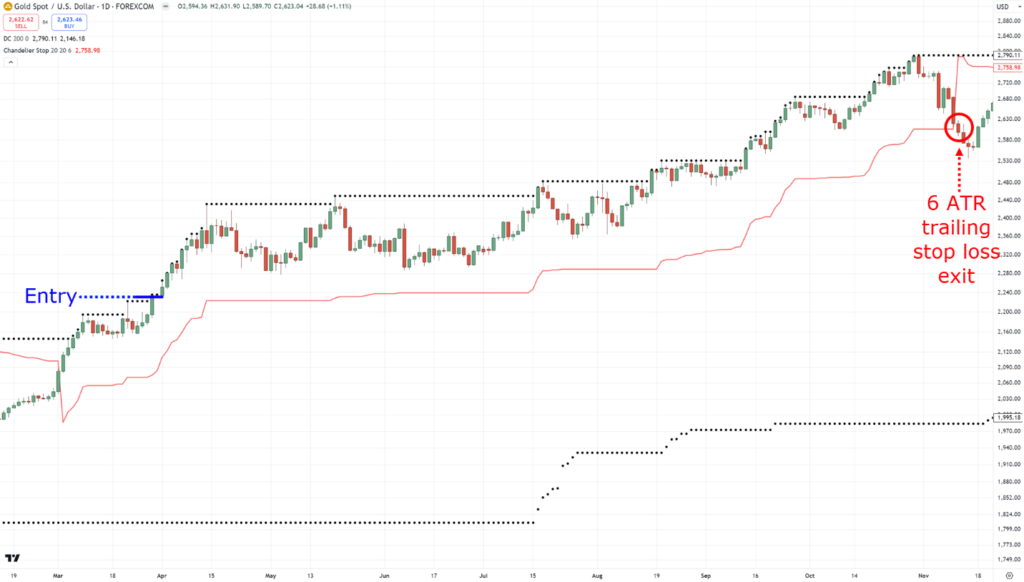
Vice versa for shorts, and that’s pretty much it.
There is no looking at fundamentals, no drawing of any support and resistance, just pure systematic trading.
And yes, this is a strategy I’ve been using for years, which is inspired by Andreas Cleanow’s following the trend…
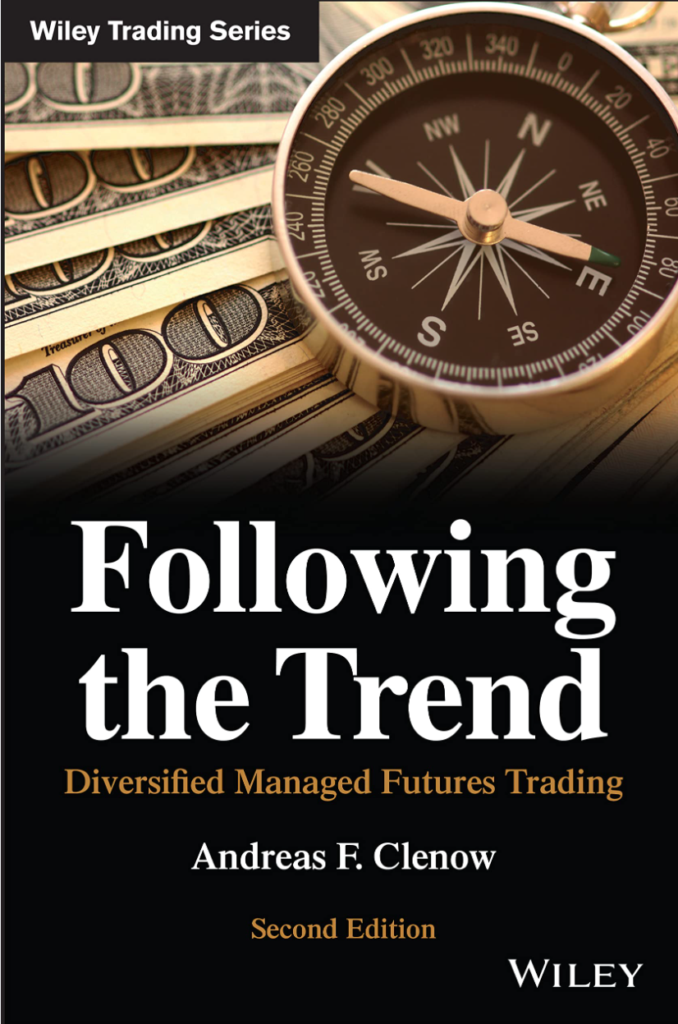
One major upside, of course, is the simplicity of the system!
It’s very easy to be consistent with it!
But at the same time there’s no flexibility on which timeframe you trade, and having a systematic trading strategy means that it’s designed to capture a specific market condition., which is…
…the trend!
That’s why I have my second portfolio, which is a discretionary trading price action portfolio…
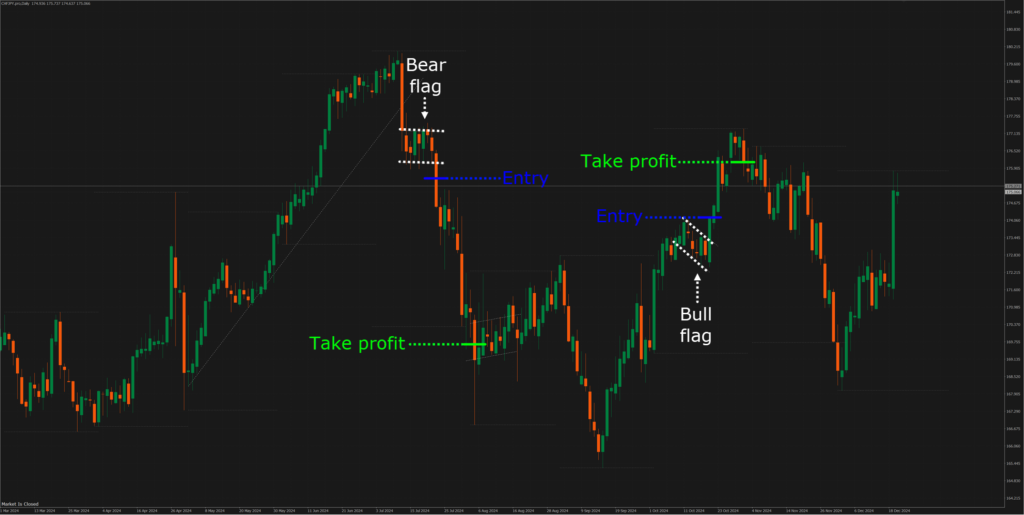
This allows me to trade all market conditions, from breakouts to pullback setups on the forex market!
With a discretionary portfolio, you also have the flexibility to decide whether or not you should use a trailing stop loss or a fixed target profit!
However…
This takes time to master and quite a lot of practice to recognize your setups on the chart.
Let alone draw the tools you plan to use, such as a trend line or support and resistance.
But hey, that’s why I have two trading portfolios!
Both are different, but they aim to complement each other.
Overview of trading platforms
For my systematic trading portfolio, I use the broker CMC Markets.
This is one of the few brokers that offers thousands of markets to trade!
And yes, when it comes to a trend-following system, diversification is key.
So, there will often be times when I would have 10-20 open trades at a time, which helps with the system’s returns and is something CMC Markets can do!
As for my discretionary account, I use the good old MetaTrader 4.
There’s no denying it.
MetaTrader 4 is a time-tested platform whose strength is to trade the Forex market.
Since my discretionary trading portfolio trades the Forex markets alone, building consistency in trading with MetaTrader 4 is a no-brainer!
Overview of trading routine
Whenever you’re looking for a trading platform, this feature is a must…
Multi-charts…
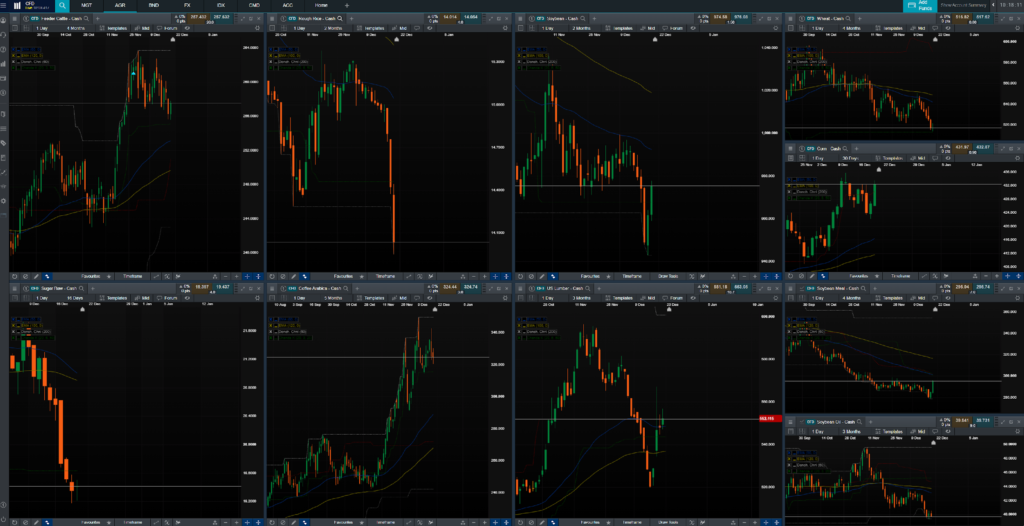
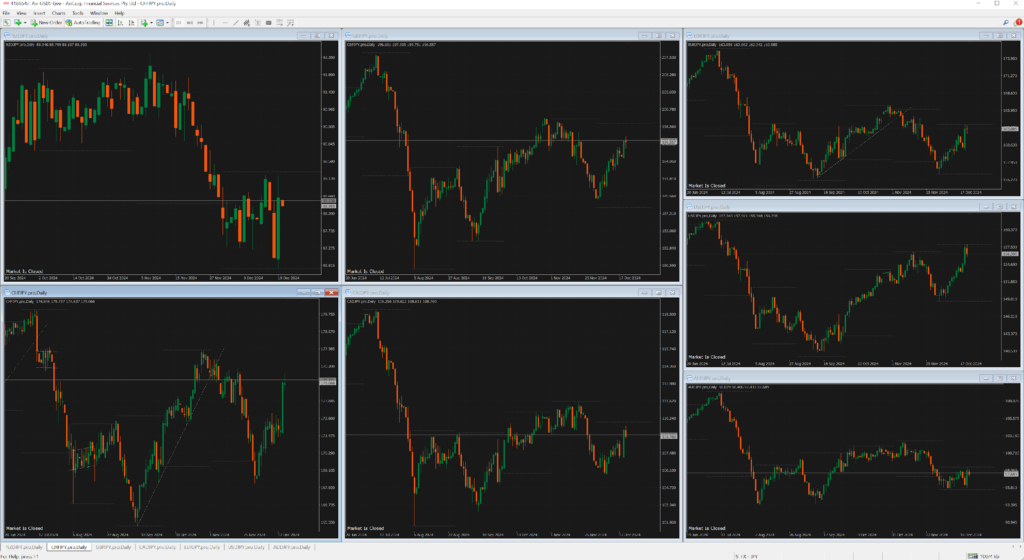
This one feature of both CMC Markets and MetaTrader 4 is my number one key to being consistent in trading, as it gives you a glimpse of many potential setups in different markets in just a few seconds!
So, how do I go about using it daily?
First, I start with MetaTrader 4 every 9 am.
I look at my watchlists, all summed up in the multi-chart
And I simply look for a “setup.”
That’s right, I don’t plot my support and resistance or do any analysis right out of the bat.
I look for setups that can be a breakout setup of a bear flag pattern…
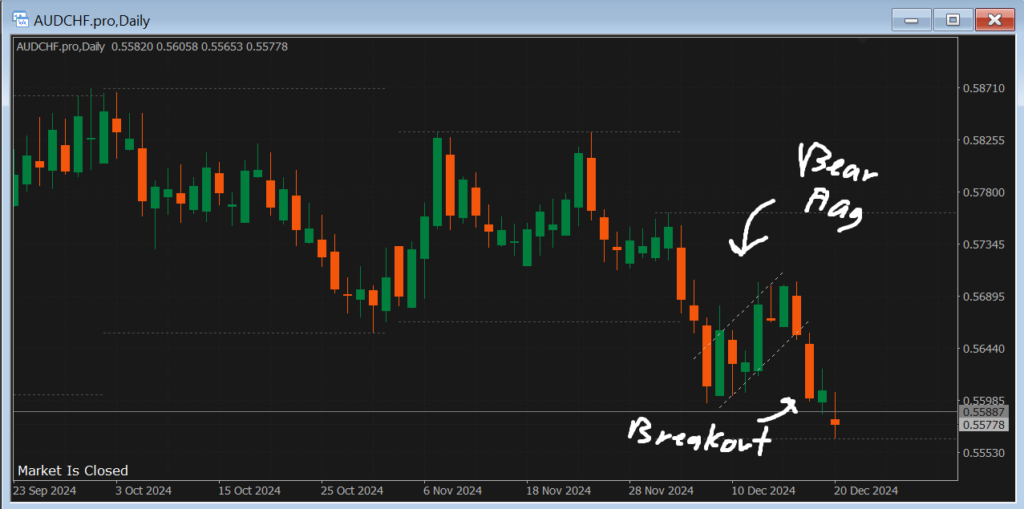
Or a pullback setup from an area of support reversal…
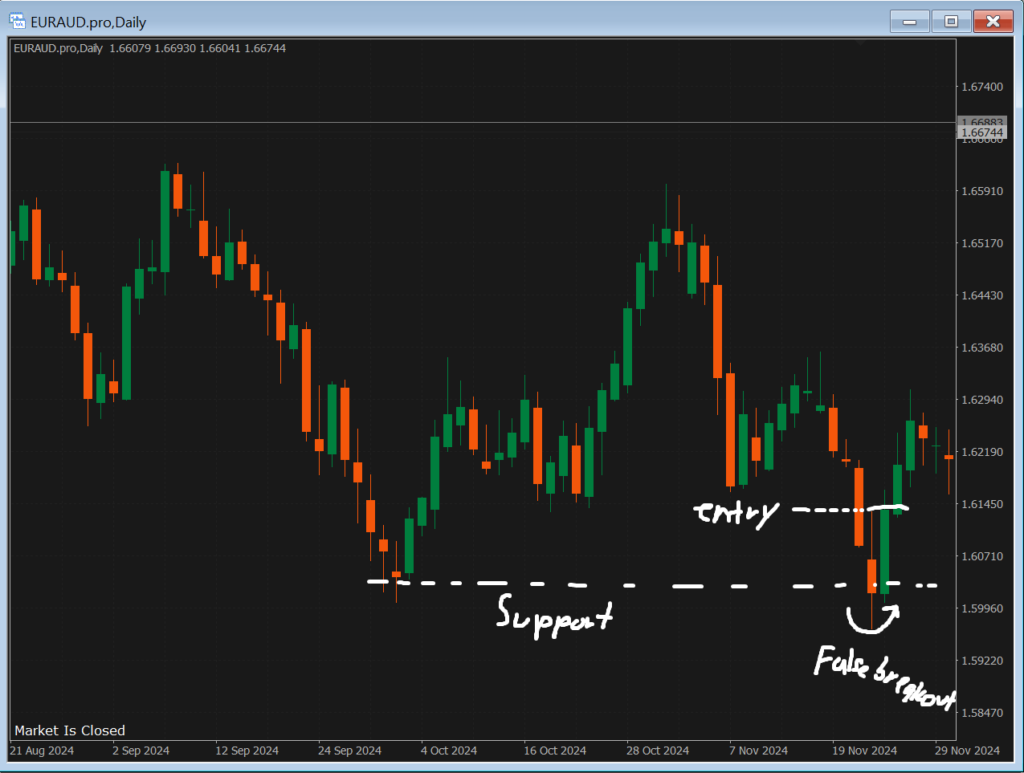
Once I spot a setup on my watchlist, such as here, for example…
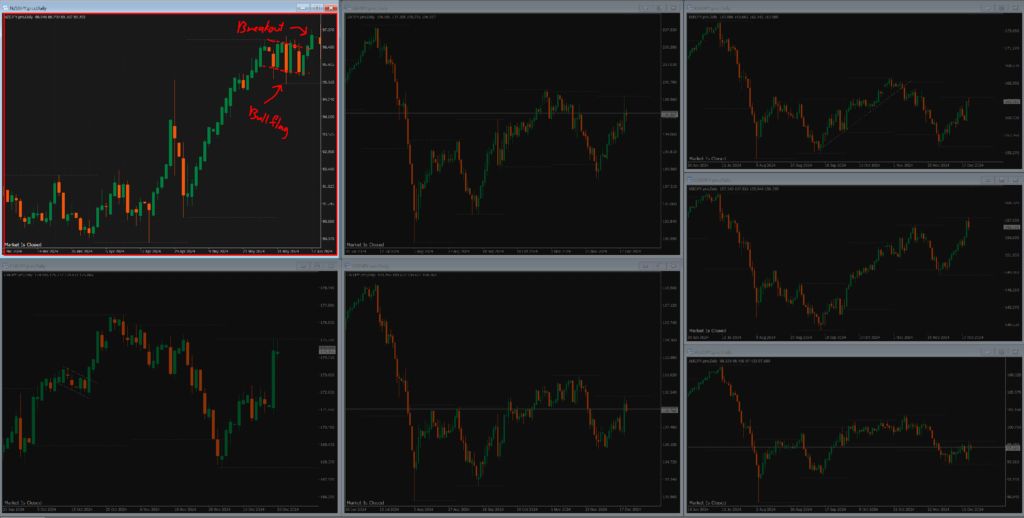
Then, that’s the only time where I analyze the chart in full and decide whether or not I should enter the trade.
This process normally takes less than 5 minutes!
Afterward, I proceed to CMC markets and look at my multi-chart watchlists…
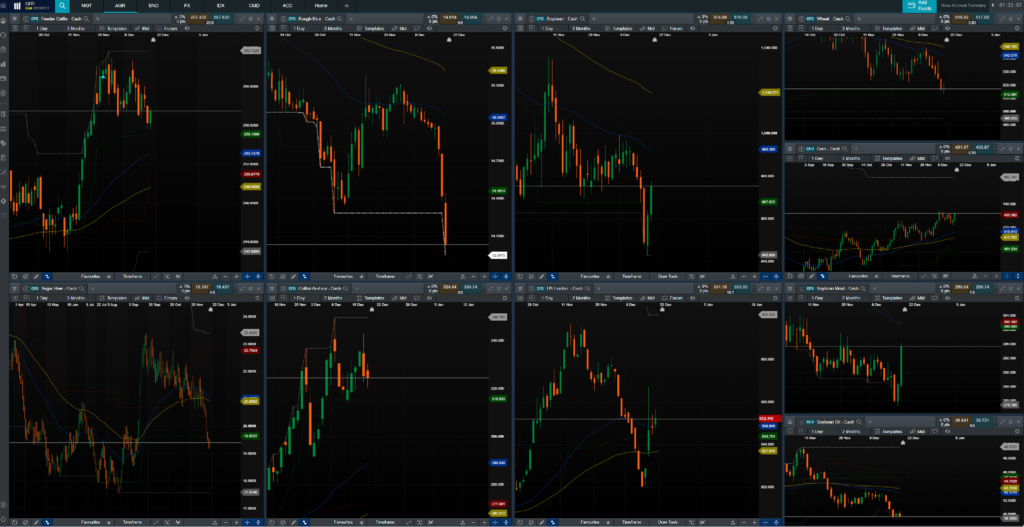
And what am I looking for?
That’s right, looking for a 200-day high or low breakout using the Donchian Channel.
And in this case, there’s a short setup for Rough Rice, and that’s pretty much it!…
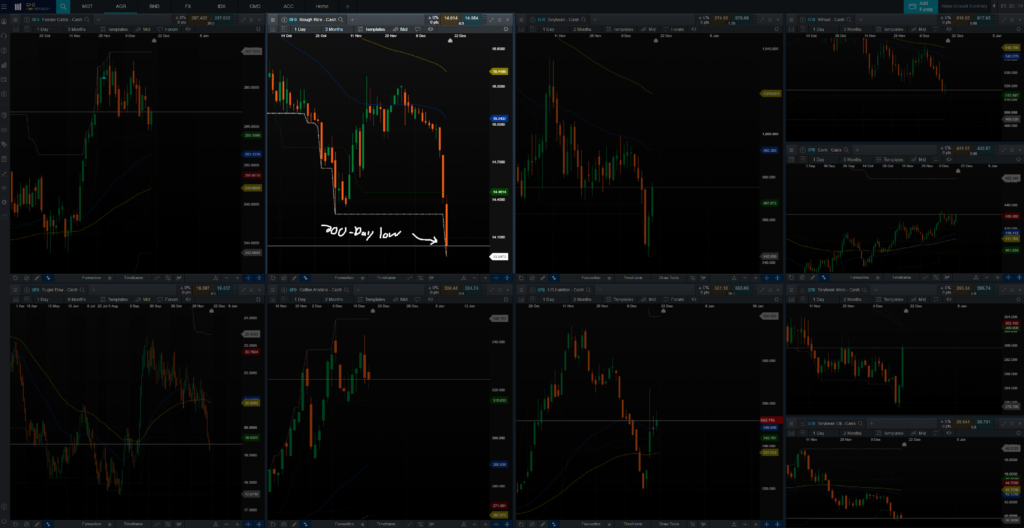
Since this is a long-term trading strategy, I normally don’t get new setups.
Nonetheless, this process takes less than 3 minutes.
And now you might be wondering:
“What do you do now for the rest of the day?”
“When should you check your charts again?”
The answer is this:
I don’t look at my charts for the rest of the day.
I do the same process that I shared with you the next day at 9 am!
You see…
The longer you stare at your portfolio, the higher the chances of you messing up your consistency in trading.
This is why you need a specific schedule on when you should and shouldn’t check your charts.
And… there you go!
An example of how I operate my trading business daily!
Now, I’ve done my best to share and demonstrate practical tips on achieving consistency in trading.
But the reality is that you and I are two different traders.
So, the journey that got me towards consistency in trading will differ from yours.
Got it?
You are the only one who can discover what works for you the best.
With that said, let’s do a quick recap of what you’ve learned today…
Conclusion
If you’ve reached the end of this guide, then I would like to congratulate you!
You should now have an overview picture of what it takes to be consistent in trading.
And at this point…
You should also know that achieving consistency in trading is all about developing the proper routine and habits that nurture good trading.
Here’s what you’ve learned today:
- Consistency in trading means choosing a strategy, maintaining a routine, and starting small when trading live
- If you’re facing significant losses, take a break to reset, manage expectations, and focus on learning
- Finding the right strategy involves trial and error — discovering what works by ruling out what doesn’t
- As an example, I manage two portfolios with different brokers and check them daily at a set time
That’s pretty much it!
A complete guide and context on how to achieve consistency in trading.
So now, over to you…
What part are you in right now in your trading journey?
Are you close to developing consistency in trading?
Share your trading journey with me in the comments below.
I’ll be waiting!


